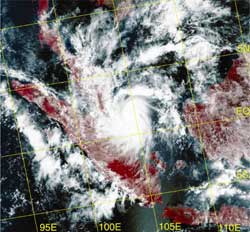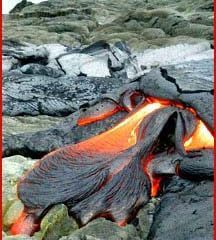Earth Sciences
Earth Sciences (also referred to as Geosciences), which deals with basic issues surrounding our planet, plays a vital role in the area of energy and raw materials supply.
Earth Sciences comprises subjects such as geology, geography, geological informatics, paleontology, mineralogy, petrography, crystallography, geophysics, geodesy, glaciology, cartography, photogrammetry, meteorology and seismology, early-warning systems, earthquake research and polar research.

Magnetic probe for rocks, recordings, nanotechnology
A technique for studying the magnetic properties of rocks developed by earth scientists at UC Davis is drawing attention from other scientists and the magnetic recording industry.
An international group of scientists recently met in Davis to discuss the First Order Reversal Curve (FORC) method and its applications for studying million-year old rocks, thousand-year old lake sediments, modern hard drives and wholly new kinds of materials made in the lab.
Magnetic materials are made

Unique NASA Satellite Watches Rainfall from Space
Your local weather forecaster uses Doppler radar systems, covering U.S. regions, to estimate rainfall and flooding, but NASA research satellites can see rainfall worldwide.
Data from NASA’s Tropical Rainfall Measuring Mission (TRMM)satellite, along with information from other satellites, allows researchers to see how much rain is falling over most of the world every three hours. This capability enables scientists to daily map areas of potential flooding.
These maps, available

Hurricanes at the Equator: "Impossible Perfect Storm" Observed
Hurricanes cannot form near the equator, or so meteorology textbooks maintain. But a storm named Typhoon Vamei upended scientists’ thinking when it swirled above the equator in the South China Sea near Singapore on December 27, 2001. It formed so close to the equator that its winds howled in both hemispheres.
New research funded by the National Science Foundation (NSF) and the U.S. Navy’s Office of Naval Research reveals the unusual mechanism for the birth of such a storm.

Rapid Release of Sea-Floor Methane Caused Extreme Global Warming 55 Million Years Ago
Scientists have just returned from two months at sea aboard the oceanographic drill ship JOIDES Resolution where they studied the effects of a larger than expected methane release 55 million years ago that may have caused extreme global warming.
In March, the scientists traveled to a site near Walvis Ridge — an ancient submarine mountain chain off Africa—as part of the NSF-supported Ocean Drilling Program (ODP) Leg 208. The researchers searched for evidence of roughly 2,000 gigatons of meth

A fiery debate about volcanoes
In a Perspective in the May 9 issue of Science, geochemist Don DePaolo and geodynamicist Michael Manga defend a fundamental assumption of Earth science, the mantle plume model of hotspots, against an outbreak of seismic skepticism.
DePaolo and Manga are members of Lawrence Berkeley National Laboratory’s Earth Sciences Division and the University of California at Berkeley’s Department of Earth and Planetary Science. DePaolo studies the chemical signatures of geological structures l

Meteorites rained on Earth after massive asteroid breakup
Geologists find meteorites 100 times more common in wake of ancient asteroid collision
Using fossil meteorites and ancient limestone unearthed throughout southern Sweden, marine geologists at Rice University have discovered that a colossal collision in the asteroid belt some 500 million years ago led to intense meteorite strikes over the Earth’s surface.
The research, which appears in this week’s issue of Science magazine, is based upon an analysis of fossil meteor